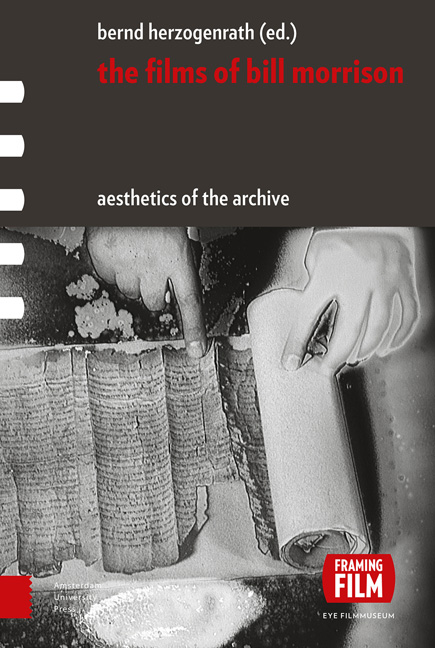Book contents
- Frontmatter
- Contents
- Acknowledgments
- Aesthetics of the Archive: An Introduction
- Chapter 1 Drafts and Fragments: Reflections around Bill Morrison and the Paper Print Collection
- Chapter 2 The Film of Her: The Cine-Poet Laureate of Orphan Films
- Chapter 3 Ghost Trip: Searching for Potential Myths
- Chapter 4 Decasia: The Matter | Image: Film is also a Thing
- Chapter 5 The Mesmerist: Illustrating the Return of the Repressed
- Chapter 6 Light is Calling: Celluloid Dreams
- Chapter 7 Gotham: Zoetrope: Block by Block
- Chapter 8 Outerborough: Early Cinema Revisited
- Chapter 9 The Highwater Trilogy: Thinking the Liquid – On the Ethics of Water and the Material Ecologies of Disaster and Ruination
- Chapter 10 Porch: Archives, Collective Memory, and the Poetics of Home Movies
- Chapter 11 The Future Lasts Long: The Romanov Lost Family Archives
- Chapter 12 Who by Water: Variations on Matter, Figures, Memory, and Mythology
- Chapter 13 Every Stop on the F-Train: Beyond and within the Restless Netherworld of (Manhattan’s) Mind
- Chapter 14 Spark of Being: Bachelor Machine
- Chapter 15 The Miners’ Hymns: Acts of Resurrection
- Chapter 16 Tributes – Pulse: A Requiem for the 20th Century: Death | Drive | Image
- Chapter 17 Just Ancient Loops: The Loops of Life in Intonation
- Chapter 18 The Great Flood: Water is Transparence Derived from the Presence of Everything
- Chapter 19 Re-Awakenings: Bill Morrison in Conversation
- Index of Film Titles
- Index of Names
- Index of Subjects
- Already Published
Chapter 9 - The Highwater Trilogy: Thinking the Liquid – On the Ethics of Water and the Material Ecologies of Disaster and Ruination
Published online by Cambridge University Press: 12 December 2020
- Frontmatter
- Contents
- Acknowledgments
- Aesthetics of the Archive: An Introduction
- Chapter 1 Drafts and Fragments: Reflections around Bill Morrison and the Paper Print Collection
- Chapter 2 The Film of Her: The Cine-Poet Laureate of Orphan Films
- Chapter 3 Ghost Trip: Searching for Potential Myths
- Chapter 4 Decasia: The Matter | Image: Film is also a Thing
- Chapter 5 The Mesmerist: Illustrating the Return of the Repressed
- Chapter 6 Light is Calling: Celluloid Dreams
- Chapter 7 Gotham: Zoetrope: Block by Block
- Chapter 8 Outerborough: Early Cinema Revisited
- Chapter 9 The Highwater Trilogy: Thinking the Liquid – On the Ethics of Water and the Material Ecologies of Disaster and Ruination
- Chapter 10 Porch: Archives, Collective Memory, and the Poetics of Home Movies
- Chapter 11 The Future Lasts Long: The Romanov Lost Family Archives
- Chapter 12 Who by Water: Variations on Matter, Figures, Memory, and Mythology
- Chapter 13 Every Stop on the F-Train: Beyond and within the Restless Netherworld of (Manhattan’s) Mind
- Chapter 14 Spark of Being: Bachelor Machine
- Chapter 15 The Miners’ Hymns: Acts of Resurrection
- Chapter 16 Tributes – Pulse: A Requiem for the 20th Century: Death | Drive | Image
- Chapter 17 Just Ancient Loops: The Loops of Life in Intonation
- Chapter 18 The Great Flood: Water is Transparence Derived from the Presence of Everything
- Chapter 19 Re-Awakenings: Bill Morrison in Conversation
- Index of Film Titles
- Index of Names
- Index of Subjects
- Already Published
Summary
ABSTRACT
Morrison's 2006 film The Highwater Trilogy exposes the medium of film to and in its existential condition: the liquid. The exceptional states evoked by the forces of water on the image level, and the material decay of the emulsified celluloid filmstrip fuse the episodes in an at once disturbingly repelling and compelling way. In Morrison's film, the liquid far exceeds a metaphorical meaning that addresses the fluidity of the moving image. As a dynamic assemblage, it invites a rethinking of conventional anthropocentric understandings of ecology as concerning merely the natural surroundings in which humans live. The natural and the social yet form complex networks, which not least redefines our perspective on human and nonhuman agency.
KEYWORDS
ecology, experimental film, film philosophy, wet ontology
The Highwater Trilogy (2006) consists of monochrome found footage of three different liquid environments recorded in the 1920s. While the episodes relay the theme of man's encounter with water – an uncontrollable force that, apart from its beauty, always bears the potential of posing a threat to humans and their dwellings, thus causing ecological disaster – this liquid theme also permeates the structural component of analogue filmmaking as the development of celluloid images demands a submergence in photochemical emulsion. After decades of storage in film archives, the film footage has started to chemically decompose, not only making the fragile materiality of the medium perceptible, but also stressing a conception of cinema as material process (Ivakhiv 2013, 33). In a media-philosophical sense, then, the film is an active component in reflecting on the philosophical implications of the physical and biological relations that are involved in its creation and production (Ivakhiv 2013, 33) and in philosophizing (Sinnerbrink 2014) on its status as an inherently wet medium. While the increasing ‘emergency state’ of the dying images throughout the film – as it literally ‘runs out of time’ in (digitized) time – poses a temporal paradox to the notion of cinema as time-based medium that captures and preserves the moment, the ephemerality of the footage and the corrosive process of materiality also appears as a ‘creative agent’ (Bennett 2010, 65).
- Type
- Chapter
- Information
- The Films of Bill MorrisonAesthetics of the Archive, pp. 151 - 166Publisher: Amsterdam University PressPrint publication year: 2017



